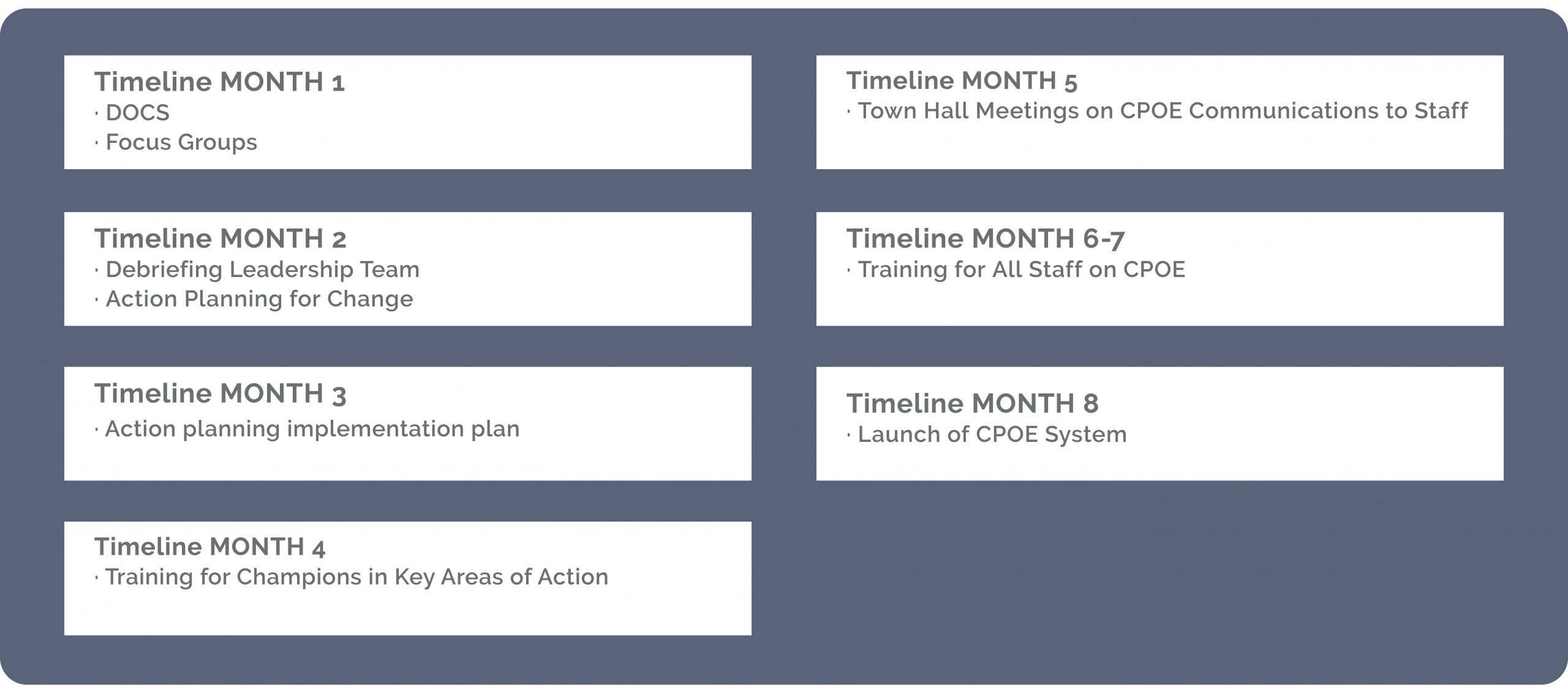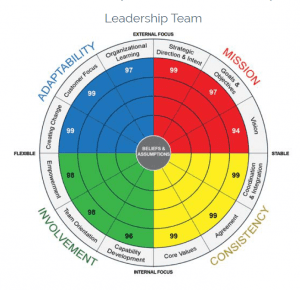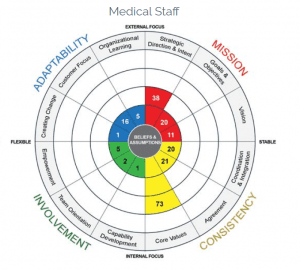
Change Readiness at Adventist Health System:
How Organizational Culture Can Help Hospitals Implement CPOE Successfully
Carlyle Walton, CEO of Metroplex Health System faced a difficult challenge.
As the new CEO of the 223-bed, multi-campus facility operated by Adventist Health System, Walton walked into an organization that on the surface, was operating well, but was characterized by silos, mistrust, and resistance underneath. They were also about to embark on a hospital-wide project to implement a Computerized Provider Order Entry (CPOE) system—a tough challenge for hospitals even in the best of circumstances. As a new CEO still trying to understand his new organization, Walton needed help in getting the hospital team through the transition successfully while continuing their mission to serve their patients with excellence. Walter certainly had a lot to do. Thankfully, Dr. Philip Smith, MD, Chief Medical Information Officer at Adventist Health System, and his team were there to help.
Organizational Culture and CPOE: A Process for Implementation.
Philip A. Smith, MD, was the Vice President of Information Services and the Chief Medical Information Officer for Adventist Health System at the time. One of Smith’s first directives in these roles was to implement Computerized Provider Order Entry Systems (CPOE) in each of Adventist Health System’s 38 hospitals.
There are several advantages of CPOE:
- Reducing errors that can occur with handwritten orders
- Improving safeguards for drug interactions and allergies
- Reducing lag time between order and delivery to patient
- Improving overall quality of the patient experience
However, implementation of a CPOE system is not as easy as simply installing a new program on the hospital’s computer system, however. Many hospitals and health care facilities underestimate the vast organizational changes required to successfully implement this system.

Challenges include: new work for clinicians, changes in workflow, resistance, negative feelings toward technology, changes in communication patterns and practices, fear of an overdependence on technology and a whole host of adjustments to the organizational structure, culture and roles within the organization.
“Most hospitals are doing it backwards,” states Smith. “They aren’t looking at any kind of organizational assessment along with the CPOE implementation and addressing the cultural aspects necessary to make the engagement work. Those hospitals aren’t having the same kinds of successful implementations that we are having.” According to Smith, hospitals must look at the way the organization works as a part of their CPOE implementation to get it right.
Smith and his team of three organizational specialists developed a multi-faceted approach to implementing CPOE within the hospitals of Adventist Health System with great success.
Through their Change Management Analysis, they worked with the hospitals to identify and create changes necessary to make the organization work effectively. Their approach started with an examination of the hospital’s organizational culture in order to assess their readiness for change.
The Denison Organizational Culture Survey (DOCS) was administered to a cross section of employees at each hospital, which included a sample of the Executive Team, Management, and Medical Staff. Within the DOCS, Smith’s team asked some very targeted open-ended questions, including: “What part of your role keeps you awake at night?” and “What line of service do you think needs the most improvement?” They also conducted a series of interviews with the groups to dig a little deeper into the current context of the hospital.
I have found the Denison Organizational Culture Survey and the work that Dr. Smith and his team have done to be extremely beneficial to our organization as a whole — I have thanked Dr. Smith repeatedly for introducing the process into our organization because it’s a whole lot more than implementing CPOE.”
~ Carlyle Walton, CEO
I have found the Denison Organizational Culture Survey and the work that Dr. Smith and his team have done to be extremely beneficial to our organization as a whole — I have thanked Dr. Smith repeatedly for introducing the process into our organization because it’s a whole lot more than implementing CPOE.”
~ Carlyle Walton, CEO
The DOCS helped the hospital identify issues that they may have had in terms of communication, trust, mission and vision, customer service, empowerment, training and development, and workflow processes, important issues to identify when implementing a change as far reaching as instituting CPOE. Smith and his team conducted a half-day workshop with the leader and their team to debrief the results; helping them to understand what their current organization looked like and what to expect.
In one case, the DOCS results helped reveal that the hospital staff wasn’t feeling empowered. When Smith and the leadership team dug deeper, they realized that this was the result of operational decisions made years prior during a time of crisis that required a supervisor’s approval for any decision to be realized. The hospital then reviewed that process and realized it wasn’t working for them anymore; they were able to put changes in place to rebuild trust and empowerment within the staff. Another hospital group acknowledged that communication at the leadership level was ineffective. Upon further review, Smith’s team recognized that all meetings were done in a room that was set up like a classroom. A simple change to reconfigure the physical setup of the room into a circle or a U-shape helped promote active communication within the group.
These are two simple examples that show the effect unproductive beliefs can have on the behaviors of an organization as a whole. These are important behaviors to address in the early stages to lay the groundwork for a successful CPOE implementation.
During the course of the next 90 days, ten champions from the Vice President and Director levels were identified from within the organization to receive training in areas such as communication, workflow and measurement. They were to work on specific issues identified within the culture survey results in the context of the CPOE implementation. For example, if trust was an issue in the organization, Smith’s team and the hospital team would tailor their strategies for the CPOE project with that in mind, giving the champions the knowledge and training they needed to be successful.
For the next two months, town hall meetings were held with questions about the new system. “Sneak Peek Stations” were set up throughout the hospital to allow personnel to look through the system. Smith’s team and the champions gave special focus to high-risk groups, including specific doctor groups and the billing department to give them the extra guidance and support necessary to overcome any apprehension. Six weeks of training was then process took about eight months to complete.
Sample Change Readiness

This is a sample timeline for using the DOCS based on the work of Dr. Smith and his colleagues. This solution first assessed the hospital’s change readiness and allowed them to begin to make the necessary changes to their organizational structure to implement CPOE effectively.
Why is Culture Important?
During the process, Smith and the leadership team on the DOCS survey results in the hospital. Oftentimes, Smith had found that there was a very large disconnect between how different groups saw the hospital. The survey was instrumental in helping them uncover this. “It’s pretty incredible because when they had this information, they immediately became more honest with us. It was almost magical,” stated Smith.
“It helped us break down any resistance or barriers we faced because they didn’t reject it. Instead, it really got the conversation going and established our credibility as a team.” Many times, when looking at the leadership team’s Culture Survey results, the leaders had a very strong opinion of themselves-in many cases, a full color profile. As you dug down deeper into other levels of the organization, the color on the profile became much more sparse. Smith’s team used this to their advantage: “The experience established for us that we knew the leadership team could play the game – they knew how to take the surveys. We showed them the qualitative data such as the open-ended responses that they couldn’t argue with and it established our credibility-allowing the facade to fade and real conversations to take place,” says Smith.
“In many ways, this process was most important for the leadership team,” comments Smith .Helping the leadership team create a solid business case for implementing CPOE enabled them to respond better when they met with resistance from within the hospital. “I’ve seen other implementations where the executive team caves in when the physicians are resistant,” says Smith. “It’s really hard to recover from that.” Therefore, hospitals can’t afford to underestimate the organizational changes that arise with such an important implementation.

What Happens in Real Life?
No one knew this process and the effects that it had on a hospital organization better than Carlyle Walton. Walton was privileged to go through this process with Smith not once, but twice: once at Takoma Regional Hospital in Greeneville, Tennessee and again at Metroplex Health System in Killeen, Texas. In both instances, the DOCS was utilized as a key tool to gauge the organization’s readiness for change.
Walton found Denison’s ability to segment the data based on different stakeholders to be a key advantage in the process. Getting a pulse on the different groups and then tailoring the plans for those groups possibly at risk was critical to the hospitals at each of the sites. Walton also immediately saw more to the process than just CPOE. “It was clear to me that the information relayed by the Denison results transcended the CPOE implementation and we found the DOCS to be an excellent tool to truly unmask the organization. It forces you to look into the mirror relative to where you are as an organization.”
It was clear to me that the information relayed by the Denison results transcended the CPOE implementation”
~ Carlyle Walton, CEO
It was clear to me that the information relayed by the Denison results transcended the CPOE implementation”
~ Carlyle Walton, CEO
Challenges at Metroplex Health System
Metroplex took the DOCS survey and completed the CPOE process eight months later. “Coming in as a new CEO, the Denison survey and interview results presented by Smith and his team were extremely helpful and also extremely painful, to be honest,” says Walton. The previous two years had been tumultuous for Metroplex. They had merged with long-time competitor, Scott & White. Before the merger was final, news of the deal was leaked inside Metroplex causing a major erosion of trust between the hospital staff and the administration. The DOCS results highlighted the divide between the medical staff and the administration and brought to light a detached perception held by the administration. Walton observed that the Culture Survey results showed that the the leadership team believed that they were highly committed to the Mission of the hospital but that they had an over-inflated opinion of their culture relative to how the rest of the hospital saw it. “When the results say something you don’t like,” says Walton, “it’s easy to start asking questions about validity of the instrument or look for excuses. We knew we had to get beyond that and clearly communicate to our team that it wasn’t about good or bad but about our culture and how we see ourselves. We were telling ourselves through these results that we needed to be consistent in what we do and how we function.” After the shock of the results, it was clear to all that they needed to use the CPOE implementation process as an opportunity for organizational transformation. The challenge was going to be in communicating the results clearly and in creating actionable plans.
The DOCS results were shared by Dr. Smith and his team with the hospital staff, which gave credibility to the results and offered a secure sense of anonymity and confidentiality to the results. Hospital members were assured that they were listened to and that their story was told. Results were also shared through a special edition of the employee newsletter dedicated to sharing the DOCS results. It explained to all the hospital employees the positive results of the survey as well as the opportunities for change.
Before the formal process of implementing CPOE within Metroplex took place, Smith, Walton and the leadership team began addressing cultural issues in order to lay the groundwork for a successful implementation. First, they addressed the perception that the administration was “in an ivory tower”, not very approachable or trustworthy.
Walton and the other leaders needed to make themselves more visible throughout their facilities. As a result, the leadership team dedicated themselves to taking part in daily hospital life by participating in department meetings, having intentional conversations and being readily available to medical and hospital staff.
Walton himself started having monthly “President’s Luncheons” with 25 randomly selected employees. These luncheons were designed as an opportunity for Walton to listen to the staff answer two key questions: What do you like about being here? And what can we be doing better? The action items from those meetings were then communicated back to the participants with timeframes for completion. They consciously began to create a culture of organizational openness, accountability and responsiveness.
Leadership and Medical Staff Perceptions of Culture at Metroplex Health System


These circumplexes show the stark divergence between the perceptions of the leadership team at Metroplex Health System and those of the medical staff regarding the organization’s culture. Philip Smith. MD. CM/O. and his team from Adventist Health System used these results along with their interviews and other qualitative data to open up some honest conversations with leaders at the hospital. These culture results shed light on important issues in empowerment. communication, accountability, and trust that were critical to address in order to ensure a successful CPOE implemenation.
The Denison Organizational Culture Survey provided us with a wonderful baseline to evaluate our culture and debug some of the issues that were getting in the way of improving ourselves and providing excellence to our patients.”
~ Carlyle Walton, CEO
The Denison Organizational Culture Survey provided us with a wonderful baseline to evaluate our culture and debug some of the issues that were getting in the way of improving ourselves and providing excellence to our patients.”
~ Carlyle Walton, CEO
The culture results also highlighted low Empowerment scores. Further discussion revealed that much of the approval and authority was centralized at the administration level. “The Denison results were just screaming this at us,” as Walton puts it. With the help of Smith and his team,the hospital reviewed their approval process to determine what needed administrative approval and what could be put back at the level most suited to make the decision. Low scores in Capability Development, Organizational Change, and Creating Change also emphasized a need for professional development.
The leadership team and the medical staff understood that they needed to be more intentional in their professional development plans for all critical staff members. Feedback from both the written verbatim comments and low scores in the Adaptability trait of the Denison survey allowed the hospital to attend to their Patient Experience team and redesign their entire service excellence plan. Addressing each of these areas helped lay the groundwork for the CPOE implementation that was to come.
“For me, it’s about hardwiring excellence into our organization. When our patients and their families come here, they expect a consistently excellent level of service. Coming in as a new CEO, the Denison Organizational Culture Survey provided us with a wonderful baseline to evaluate our culture and to debug some of the issues that were getting in the way of improving ourselves and providing excellence to our patients.”


